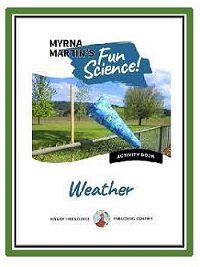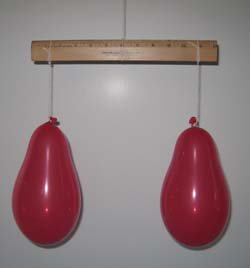Air Pressure Experiments
Does Air Have Weight?
To begin these air pressure experiments wave your hand back and forth in the air. It's easy to move your hand around because air pressure is pressing onto your hands in all directions. Air actually weighs 14.7 pounds per square inch at sea level. That means that every square inch of your body is being pressed on by 14.7 pounds of pressure.
Materials
- Balloons
- String
- Scotch tape
- Ruler(stick or clothes hanger may also be used
- Needle or sharp pin
Directions
- Cut three strings approximately 12 inches long.
- Blow up two balloons
so they are the same size. Tie a string to each balloon.
- Tie one of the
balloons to each end of the ruler tight enough so the string will not
slip.
- Tie a string loosely around the center part of the ruler so that
you can slip the knot back and forth until the balloons are balanced.
- Tape the string in place so it will not move when the balloon is
deflated. Prick one of the balloons with a needle or sharp pin.
- Watch
how the ruler moves upward on the side where the balloon was deflated.
If this does not happen it might be because the center string was not
tight enough and moved when the balloon was deflated.
- Try the experiment several more times to see if the experiment works consistently. This is the way real scientists do their work. They test their hypothesis several times to make sure the same thing happens consistently.
Extending the experiment
Try these air pressure experiments. Balance two deflated balloons on a ruler or stick. Take one balloon off the stick and inflate it. Return the balloon to see what happens. Try balancing several balloons on a yard stick. When you have the yardstick in balance. Predict what you think will happen if you deflate all the balloons, one at a time, from left to right. After writing down your prediction, try this air pressure experiment.


Click for More Information and to Order
Science behind the experiment
Air is a real substance and it has weight. That is why it weighs 14.7 pounds per square inch at sea level. What scientists mean when they give this figure is that if a column of air one square inch in size from sea level to the top of the atmosphere above Earth would weigh 14.7 pounds.
If you travel up over a mountain pass air pressure decreases as you move upward. At 18,000 feet above the Earth the air pressure is approximately 7.35 pounds per square inch or half the atmosphere at sea level.
More Links to Science Experiments
Amazing Science Experiments Try these amazing science experiments where you learn to balance a potato, fork and pencil on the edge of a table!
Cool Science Experiments, Loop Airplanes How far can you make 2 strips of paper and a straw fly through the air? Try this cool science experiment and find out!
Earth Science Experiments, Floating Eggs Fresh eggs sink in fresh water, see if you can get them to float in this fun science experiment.
Easy Science Experiment, Tin Foil Boats How many pennies do you think are the maximum you could put in a tin foil boat? Try this fun experiment and find out.
Easy Science Experiments Lots of easy experiments for kids of all ages.
Kids Fun Science The links on this page include information science activities, science experiments, plate tectonics, the rock cycle and much more
Air Pressure Experiments, Does Air Have Weight Find out in these air pressure experiments if air has weight and other fascinating facts about the air we breathe.
KIDS FUN Science Bookstore
Check out Myrna Martin's award winning textbooks, e-books, videos and rock sets. The Kids Fun Science Bookstore covers a wide range of earth science topics. Click here to browse.











